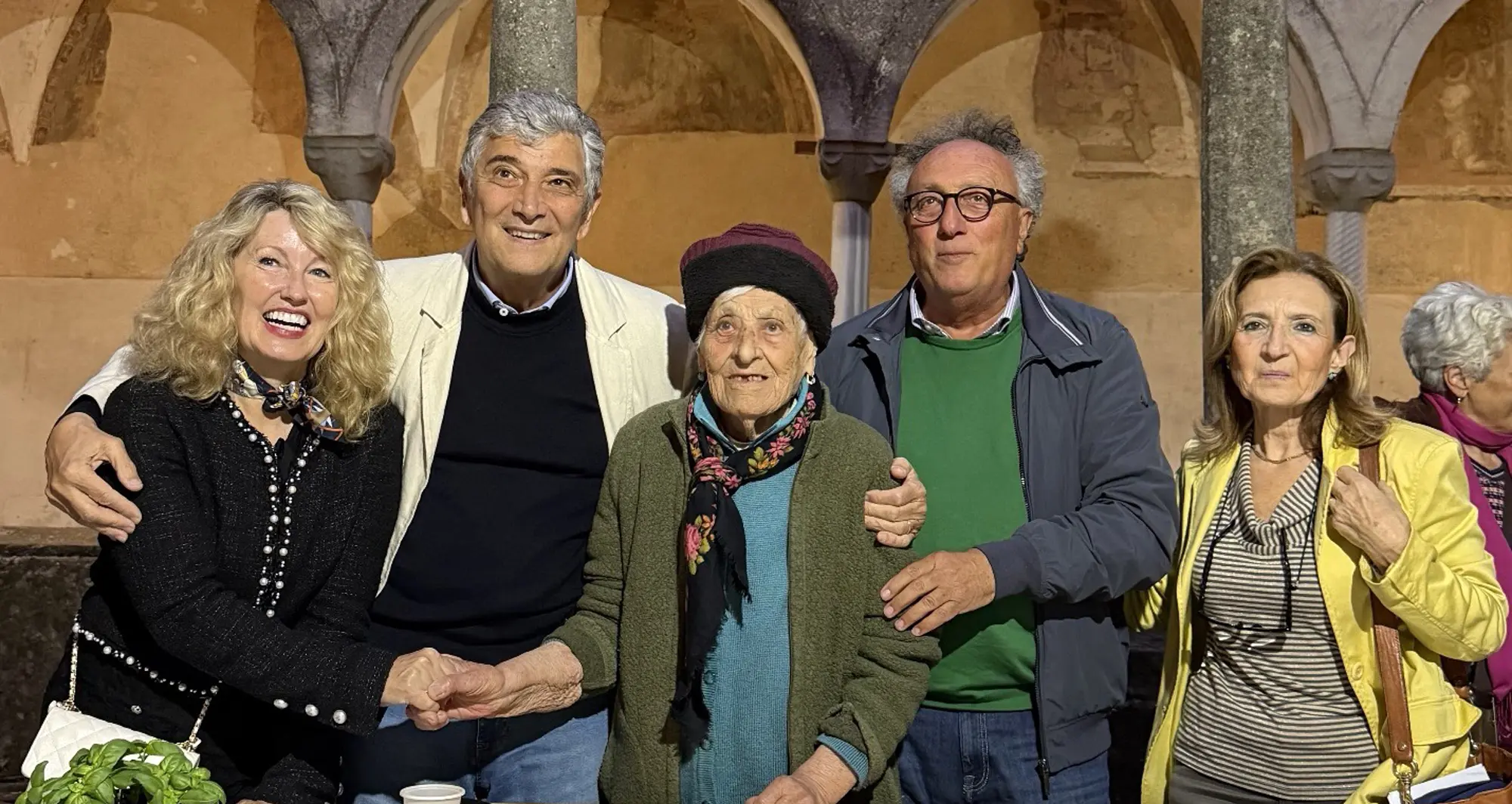On May 22-23, a select group of scientists from around the world gathered in the small town of Acciaroli in the Cilento-Salerno region of Italy to review a decade’s worth of research in the ongoing Cilento Initiative on Aging Outcomes (CIAO), a longitudinal study of local residents 100 years and older.
(The CIAO study is a multi-institution collaboration that includes Sanford Burnham Prebys, an independent, nonprofit biomedical research institute in San Diego, the Sanford Stem Cell Institute at University of California San Diego, University La Sapienza in Rome and Great Health Science, a network of public and private research organizations based in Rome, Italy.)
“The centenarians of the CIAO study are remarkably robust and healthy, and can be found here in numbers per capital greater than most places on Earth,” said Salvatore DI Somma, MD, the study’s lead Italian investigator, founder of Great Health Science and co-chair of the recently concluded symposium.
“Some aspects responsible for their long and healthy aging seem apparent, but beneath them lie the deeper elements of genetics, epigenomics, metabolomics and other new bio-analytical tools and assessments. Our goal when we began the CIAO study back in 2015 — and our continuing mission — is to more precisely define the underlying drivers of a long, healthy life and to use those discoveries to help the rest of us also live longer, healthier lives, in part by slowing or preventing diseases related to aging.”
Two major components of why the centenarians of Cilento live longer and better was reaffirmed in multiple studies: Diet and lifestyle.
Ninety percent of the centenarians in the CIAO study adhere to the Mediterranean diet, which is rich in fresh fruits, vegetables, whole grains, legumes, nuts and olive oil, with minimal red meat consumption.

“The Mediterranean diet is not a meal plan. It’s not a fad,” said di Somma. “It’s a way of life.”
The diet appears to pay health dividends, both short- and long-term. In one study, researchers reported that after just six days after shifting from a northern European diet to a Mediterranean diet metabolites (substances produced during metabolism) linked to a decreased risk of future type 2 diabetes and coronary artery disease increased significantly while biomarkers associated with red meat consumption (a risk factor for multiple diseases) declined.
A related analysis of olive oil produced in the Cilento region and widely consumed by its residents found it to be low in fatty acids and compounds associated with increased risk of heart disease or accelerated brain decline.
Additionally, most centenarians were physically active on a regular basis and socially engaged with friends and family.
“Despite their advanced chronological age, many Cilento centenarians maintain cognitive integrity, emotional stability and adaptive neurological function,” said Paola Antonini, MD, PhD, chief medical and scientific officer at Great Health Science.
“They exhibit notable resilience against age-related neurodegenerative conditions, including Alzheimer’s, Parkinson’s and cerebrovascular disorders. Psychologically, they are emotionally resilient and stable. They use optimism as a coping strategy. They have low levels of neuroticism, but a strong sense of purpose and sustained social/family engagement.”
Recent CIAO research findings are further parsing the underlying biological mechanisms. The goal is to apply the most advanced techniques in biomedical research to study the centenarians, which include single nuclear multi-omics, metabolomics, proteomics, biomarkers, and cytokine measurements.
Centenarians display a coordinated immune response to health threats
The epigenome is the multitude of chemical compounds that tell the genome (complete set of DNA in genes) what to do. As we age, progressive epigenetic alterations disrupt gene expression programs, compromise cell identity and impair genomic stability — all contributing to chronic inflammation, reduced regenerative potential and cell senescence, a state in which a cell permanently enters a zombie-like state: It no longer divides, but remains metabolically active and can release inflammatory factors that contribute to age-related diseases.
“Epigenomically, no two individuals are alike, no epigenome is the same,” said Allen Wang, PhD, senior associate director at UC San Diego’s Center for Epigenomics. “That, along with the actual complexity of disease, complicates the search for therapeutic biomarkers.”
Nonetheless, Wang said rapidly developing tools like single nucleus multi-omic profiling of blood samples, which allows researchers to simultaneously analyze several aspects of individual cell nuclei (RNA, DNA, etc.) is providing clues.
For example, in single-cell epigenomic analyses of a preliminary cohort of Cilento centenarians, researchers found that their T-cells and macrophages — components of the body’s response to infection and disease — exhibited notably coordinated immune activation and cytokine regulation. Cytokines are small proteins that act as critical chemical messengers, primarily within the immune system.
The centenarians also showed elevated antiviral and inflammatory programs, and greater communication among immune response cells.
“A cell’s epigenome is shaped by a lifetime of environmental influences,” said Wang. “In centenarians, reading these epigenetic marks may hold the key to understanding how lifestyle and diet contribute to the molecular underpinnings of longevity.”
Centenarians are biologically younger than their chronological age
Researchers surveyed metabolites associated with centenarians and cardiometabolic disease, a cluster of conditions that increase the risk for developing cardiovascular disease or metabolic disorders like type 2 diabetes.
Metabolites have various functions, including fuel, structure, signaling and acting as catalysts for chemical reactions. They can also serve as biomarkers for different diseases, improving both diagnoses and treatments, and help identify drug targets for personalized medicine.
CIAO study scientists assessed 128 centenarians and 50 controls. They found that 2,812 of the 32,514 metabolites measured differed significantly in centenarians, either in higher or lower levels. Of those 2,812 metabolites, 1,540 were significantly associated with cardiometabolic disease and 268 were deemed potentially protective against cardiometabolic disease.
Using proprietary artificial intelligence and multi-omics tools developed by Sapient, a San Diego-based biotechnology company founded by UC San Diego professor of medicine and pharmacology Mohit Jain, MD, PhD, the researchers then determined the biological age of study participants based on 24 key blood metabolite measurements.
Based on those blood samples, the majority of centenarians were biologically younger than their chronological age by an average of 8.3 years. Controls, who are also from Cilento, also appeared biologically younger, but the difference was not as pronounced.
Contrarily, the researchers found that inflammatory markers in centenarians were elevated. Chronic or excessive inflammation can be a risk factor for heart disease, autoimmune disorders and cancer.
“Our initial hypothesis was that centenarians have increased inflammatory mediators, which are expected to increase with aging,” said David Brenner, MD, president and CEO of Sanford Burnham Prebys and a CIAO study principal investigator. “However, the centenarians also have increased anti-inflammatory mediators which may protect the centenarians from inflammation and tissue injury.”
Centenarians enjoy better blood circulation
Past studies with Cilento centenarians have shown they enjoy robust microcirculation of blood comparable in efficiency to people 30 years younger. The findings also indicate low blood levels of adrenomedullin (bio-ADM), a peptide hormone that regulates blood pressure, maintains vascular integrity and may have potential protective actions in various diseases.
Low levels of bio-ADM is considered an indicator of good vascular microcirculation, and good microcirculation is an indicator for increased longevity. Andreas Bergmann, PhD, chief scientific advisor for SphingoTec, a Germany-based company that develops biomarkers, and colleagues have gone further to identify an enzyme called dipeptidyl alpha amidating monooxygenase or PAM, which potentially can be used to restore bio-ADM to healthy levels and serve as a biomarker for impaired peptide activation.
In mouse studies, therapeutic application of PAM substantially restored vascular leakage at the blood-brain barrier and improved cerebral brain flow in an animal stroke model.
In related research, researchers found that study participants in northern Europe and in the Cilento region who focused on a Mediterranean Diet for six days experienced increased bio-ADM activation and PAM levels mirroring improvement of endothelial function and microcirculation.
“PAM improves age- and Alzheimer’s disease-related cerebral malfunctions,” said Bergmann. “It improves cognition and reduces amyloid load and neuroinflammation, both factors in neurodegeneration. The Cilento lifestyle and diet help too.”
A simple takeaway
In a small pilot study, Robert Hetzel, MD, a family physician in Gisborne, Victoria, Australia, recruited 23 patients (six females, 17 males) between the ages of 55-79 to follow a “health checklist” for three years. There were five parts:
- Consume a Mediterranean diet, with two low-calorie, alcohol-free days each week
- Exercise 60 minutes daily (aerobics, muscle-building and balance)
- Sleep 7-8 hours each night
- Engage the brain through puzzles, creative arts, music
- Develop social connections
When the study concluded earlier this year, Hetzel reported that 10 patients had significantly changed health behaviors, eight had significantly increased their exercise time and five had fully adopted a Mediterranean diet. Anecdotally, many of the patients reported weight loss, better health and an improved outlook on life.
Hetzel cautioned that the pilot study’s findings were not conclusive, but were encouraging.
“A sample size of 20 patients is too small and a follow-up after just two years too short, but the study results suggest creating a health list for patients to follow can be effective,” said Hetzel, who has proposed a larger study with annual follow-ups over five years and more specific testing for elements like blood lipid levels and metabolites and more specific questions about health behaviors.
“We are generating an unprecedented amount of data on each centenarian and control,” said Brenner. “Now comes the fun part. The next steps are to develop a platform to integrate these enormous data sets developed for each individual, and then to interrogate the data with AI to gain new insights into the drivers of healthy aging.”
Media
For more information, see the symposium program or contacts below.
Sanford Burnham Prebys
Scott LaFee
VP, Communications
slafee@sbpdiscovery.org
Sanford Stem Cell Institute (UC San Diego)
Danielle Lewis
Marketing & Communications Director
dmlewis@ucsd.edu
Great Health Science
Valeria Albini
External Communications
valeria.albini@greatnetwork.org
valeria.albini@greathealthscience.com
